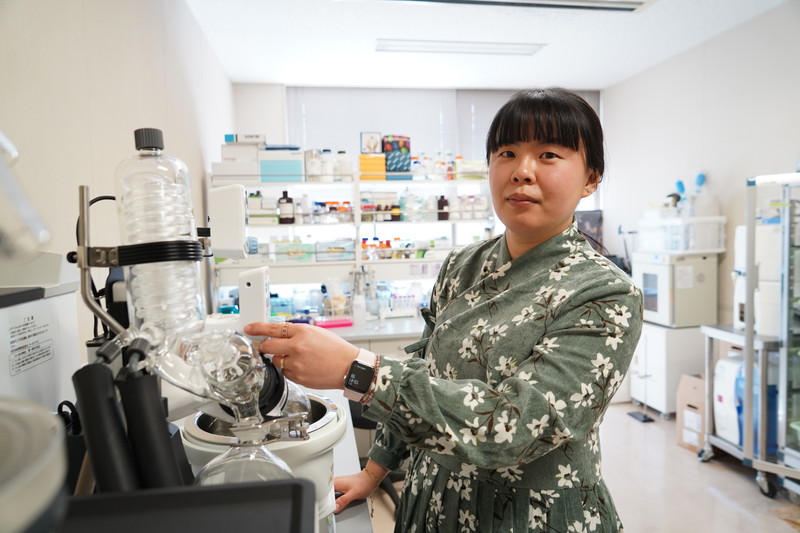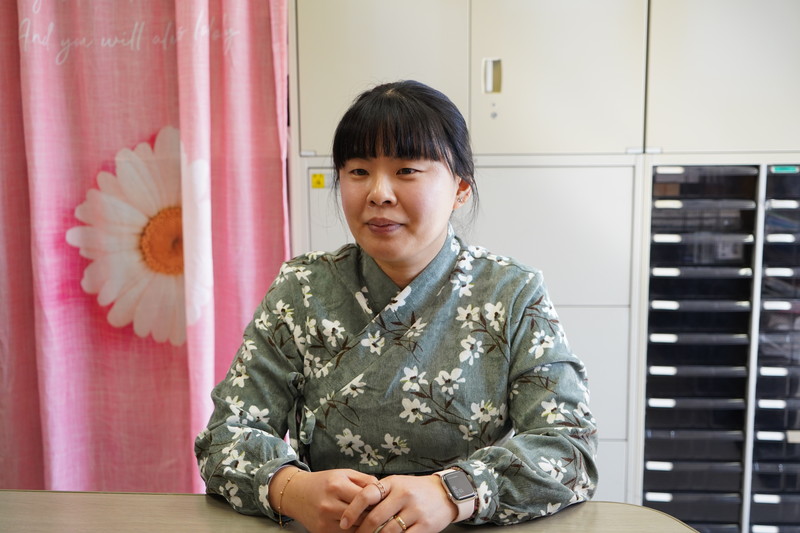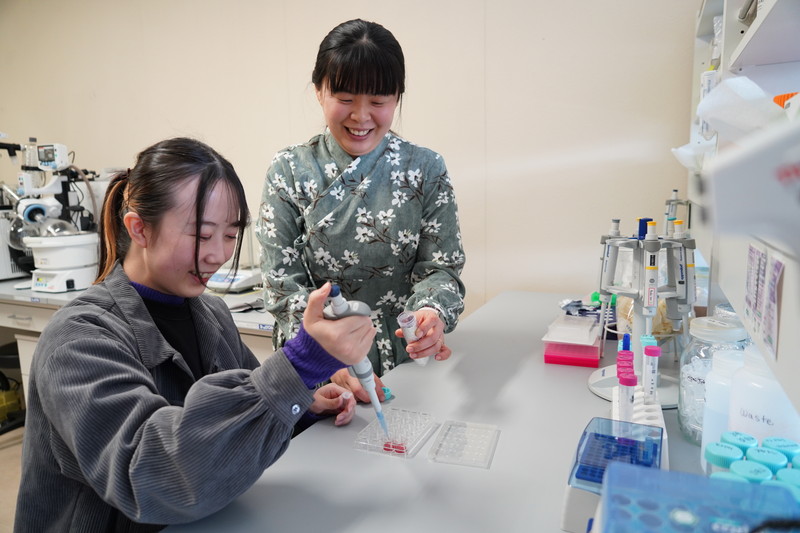NEWS
IROAST Researcher --- Assoc. Prof. Ruda Lee
English Japanese
Developing DDS for Cancer Treatment to Reduce Side Effects
Contributing to Medicine with Advanced Nanotechnology

Assoc. Prof. Ruda LEE
IROAST International Joint Research Faculty Member
Institute of Industrial Nanomaterials
(Period at IROAST: from January 2017 to December 2021)
Nanotechnology works as a bridge between biological and physical sciences by applying nanoconstructs, especially in nanomedicine and nano-based Drug Delivery Systems (DDS), where functional particles are of major interest. Nanomedicine is an emerging field that implements the use of nanoscience knowledge and techniques in medical biology and disease prevention and treatment. Associate Prof. Ruda Lee aimed to establish a novel nanomedicine that offers multiple benefits in the treatment of chronic human diseases by site- and target-specific delivery of appropriate medicines.
■ Targeting breast cancer, lung cancer, and Parkinson’s disease
Q: Please tell us about your research.
Lee: My research involves the development of a new DDS using nanotechnology. I am working on a technology that constructs nanoparticles with advanced functions and delivers therapeutic drugs loaded into these particles to disease target areas without harmful effects on the healthy parts of the body. I am using peptides that target receptors unique to cancer and immune cells. Particularly, we building a better DDS that can target breast and lung cancers and Parkinson’s disease.
This technology, which delivers drugs directly to cancer cells without affecting other cells, can certainly reduce the side effects of treatment, but we are also focusing on overcoming multidrug resistance and real-time imaging for disease diagnostics. Theranostics technology, which combines diagnosis and therapy simultaneously, is receiving considerable attention, and our goal is to contribute to further development of this advanced medicines supported by nanotechnology.

Q: Are you also actively pursuing joint research?
Lee: In terms of joint research with other fields within Kumamoto University, I started joint research with Professor Keiichi Motoyama (Global Center for Natural Resources Sciences) in the pharmaceutical sciences when I was first appointed. Moreover, I am collaborating with Prof. Guojun Sheng (International Research Center for Medical Sciences [IRCMS]) in medical sciences.
More joint researches have been conducted with foreign countries. In FY2021, I received a research grant from the Japan Agency for Medical Research and Development (AMED) under the “Infectious Diseases and Immunology Research: US-Japan Cooperative Medical Sciences Program Collaborative Awards.” In this research, I collaborated with Harvard Medical School. I am also collaborating with a Korean researcher, who was my supervisor during my graduate school days and is one of the top researchers in DDS research, and with researchers in Australia and the USA.
■ I decided to come to Japan, a country with a strong fundamental research base, which led me to IROAST.
Q: What brought you to IROAST?
Lee: Before coming to Kumamoto University, I worked as a post-doctoral researcher in Italy. When I was looking for a position to advance my research, I came across the IROAST website.
However, the opening at IROAST was an associate professor under the tenure-track system, and since I was still young, I thought it would be difficult to obtain the position. Thus, I applied to the University of Michigan in the USA and the Max Planck Institute in Europe. Although I had received employment offers from both of them, I gave up the chance and focused on the IROAST application. Even though I had no idea of the acceptance, I finally received an acceptance letter six months after the application.
Coming to IROAST was a tough decision, and it took me some time to do so. I was born in Germany and raised in Europe. I had no experience in living in Asia. However, I chose Kumamoto University’s IROAST because Japan is strong in science, especially basic research, and there are many Nobel Prize winners. Japan is close to my home country, South Korea, in both distance and culture, and I also like Japanese culture. Presently, I am very happy and glad to have come to IROAST.
Q: What is the attractive point of IROAST?
Lee: It is difficult for inexperienced young researchers to obtain a position and continue their research, but IROAST provides much support, such as research funding and encouragement of joint research. I believe that I have been given the opportunity to become an independent and good researcher.
Moreover, a system in which professors serve as mentors to tenure-track faculty members is a good arrangement. Prof. Niidome Takuro has been with me and I am grateful to him. We have similar research interests, and I am able to use his laboratory and interact with Prof. Niidome’s students, and also allowed to use equipment for my research, so I do not have to purchase new equipment. I also appreciate the opportunity to obtain full support for my learning.
Tip: Contractions refer to two words that are combined into one in casual contexts. These are used often in informal communication but generally avoided in formal communication, including academic writing.
I also think that the tenure-track system is excellent. Many researchers work in non-tenure-track positions. Therefore, after some time, researchers were required to move out and change the subject. It is difficult for them to continue to focus on their research. Compared to that situation, in my case, I could be more focused on my research after I underwent tenure evaluation. This tenure evaluation motivated me to conduct more research and helped increase my achievement. Furthermore, we can contribute to both IROAST and Kumamoto University through our research, so I believe it is a win-win relationship.
■ I am happy to engage in research in an environment open to female researchers.
Q: Are there any challenges as a female researcher?
Lee: Not only in Japan but also globally, the male researcher’s population is higher than that of female researchers. I believe that this is because women have to take time off for childbirth and family. Moreover, the stereotype that family matters in women’s work persists today. There remains an environment where it is difficult for women to concentrate on their work.
When I was a PhD student, my supervisor was a very fair person. He treated students fairly, regardless of gender or age, and I was able to write many papers. He also provided many comments on for my future works so that I could become an independent researcher.
In my case, I was lucky to have found a great advisor and to have started out as a young researcher while things are gradually changing in this era. Women have the power to improve their environment. Therefore, if you keep focusing on the path you believe in and keep walking, you can become an independent researcher.

Q: Do you have a message for overseas researchers?
Lee: I sometimes find it difficult to open up to people in Japan right after I arrived here. However, as time passed, I was able to communicate better and acquire help and even start joint research. If possible, it would be better to study the Japanese language, even if only a little.
The most attractive aspects of Kumamoto are the beautiful nature, kind people, and safe environment. I love living in Kumamoto, 100%.
Related links
- Researchmap

